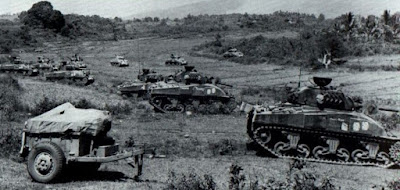The designers stressed mechanical reliability, ease of production and maintenance, durability, standardization of parts and ammunition in a limited number of variants, and moderate size and weight. These factors, combined with the Sherman's then-superior armor and armament, outclassed German light and medium tanks fielded in 1939–42. The M4 went on to be produced in large numbers. It spearheaded many offensives by the Western Allies after 1942.
When the M4 tank went into combat in North Africa with the British Army at El Alamein in late 1942, it increased the advantage of Allied armor over Axis armor and was superior to the lighter German and Italian tank designs. For this reason, the US Army believed that the M4 would be adequate to win the war, and relatively little pressure was initially exerted for further tank development. Logistical and transport restrictions, such as limitations imposed by roads, ports, and bridges, also complicated the introduction of a more capable but heavier tank.Tank destroyer battalions using vehicles built on the M4 hull and chassis, but with open-topped turrets and more potent high-velocity guns, also entered widespread use in the Allied armies.
Even by 1944, most M4 Shermans kept their dual purpose 75 mm gun. [9] By then, the M4 was inferior in firepower and armor to increasing numbers of German heavy tanks, but was able to fight on with the help of numerical superiority and support from growing numbers of fighter-bombers and artillery pieces. Some Shermans were produced with a more capable gun, the 76 mm gun M1 , or refitted with an Ordnance QF 17-pounder by the British (the Sherman Firefly).
The relative ease of production allowed large numbers of the M4 to be manufactured, and significant investment in tank recovery and repair units allowed disabled vehicles to be repaired and returned to service quickly. These factors combined to give the Allies numerical superiority in most battles, and many infantry divisions were provided with M4s and tank destroyers.
The M4 Sherman was the primary tank utilized by the United States army during World War Two. It also became the main tank of the other Allied countries, except for Russia. The popularity of the Sherman was not due to its superior design, but its availability and mass production. On the contrary, this tank suffered from serious design flaws.
Perhaps it is more appropriate to say that it was the soldiers within these tanks that bore the brunt of the Sherman's problems.
Sherman tanks first saw action in North Africa in 1942. At the time they fared well against the German equivalent tank, the Panzer IV. It was for this reason that the Army thought the Sherman would be able to hold its own during the invasion of Normandy and into Europe.
This was not the case. Death Traps , Belton Cooper's aptly name book about American armored divisions in WW2 evidences this fact.
“The 3rd Armored Division entered combat in Normandy with 232 M4 Sherman tanks. During the European Campaign, the Division had some 648 Sherman tanks completely destroyed in combat and we had another 700 knocked out, repaired and put back into operation. This was a loss rate of 580 percent."
Text / source :
University of Illinois Archives, Contributed by Nicholas Hopkins
A Glimpse of the lives of American soldiers constructed with materials of the 3rdArmored Division Archives, housed at the University of Illinois Archives Research Center
----------------------Some Destroyed Sherman tank















Ei kommentteja:
Lähetä kommentti
Any explosive ammunition or empty cores, you can put in this.